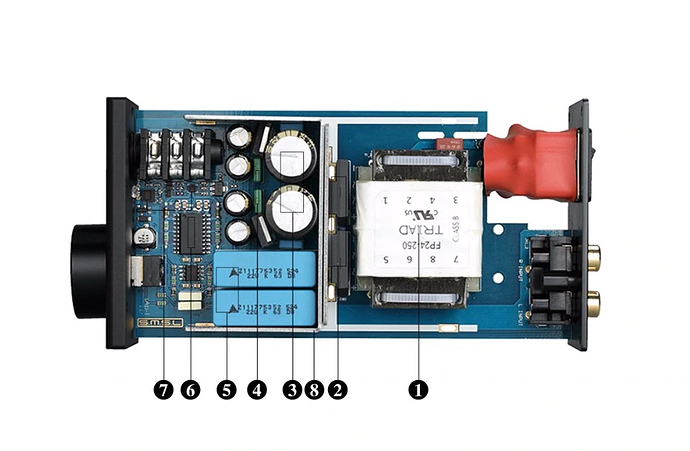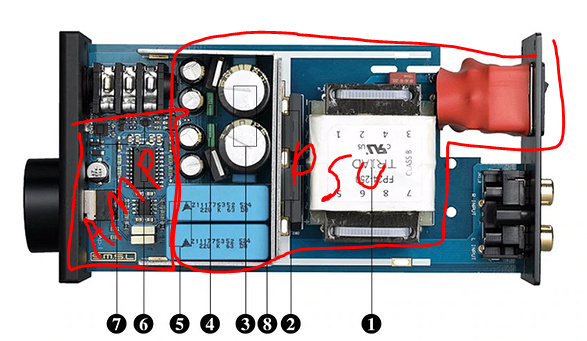Sounds like some company needs to look into their drivers…
Having a multimeter to hand to just quickly check resistance (under 15ft/5m) should always come out at 0.1 Ohm (or less) from end to end and at least 2 Mega Ohm between the poles.
Sounds like some company needs to look into their drivers…
Having a multimeter to hand to just quickly check resistance (under 15ft/5m) should always come out at 0.1 Ohm (or less) from end to end and at least 2 Mega Ohm between the poles.
RCAs.
Yes. It’s a tiny metal brick. Next to it, the Atom is like a tiny, empty plastic toy. ![]()
(I still effing love it.)

so…does that transformer really make a true class A, or just a wanna be, like M0N hinted at earlier?
I mean it most likely is class A, but I just said being class a doesn’t mean it will inherently sound good
you’re right…I sorta misquoted you. my apologies.
Manual says 5W, I guess for Class A it means it’s 5 watts “all the time” (…to finally produce 270mW @ 32 ohms). Also in the manual: 0.001% @ 100dB THD+N.
I’ll go get my cables tomorrow and I think I’ll need to A/B with a splitter. Right now it’s hard to… unplug-replug RCAs and headphones and hear the differences between the Atom and the SAP-1. First impression is, more emphasis on bass and mids for the SAP-1 versus the Atom (but no lack of anything – definitely no lack of detail either).
The transformer has nothing to do with the amplifier class. The transformer is just part of the power supply.
The unit is 4/5th PSU

As I mentioned earlier in this thread, the TPA6120A2 (marked 6 in the image) is a fully integrated Class A (technically AB) amp.
Is there a difference between A and AB? or is it just another way of saying the same thing?
Yes, there is a difference.
Details outlined here:
Then is it a A or AB? Also, in what case is a Class A a better/more desireable over a class AB, and vice versa?
It is class a/b.
Full class a for sound quality, class ab for more efficiently and more power
Im curious as to what a good cheep class A sounds like… Damn, now I have one more thing to hunt down and figure out how to stick it into my arsenal.
I mean imo I wouldn’t worry about topology, it’s all in how the designers use it and the quality of components. I wouldn’t say one is clearly better sounding than the other
Very curious to hear your thoughts on this one, since SMSL is one of the brands that is actually relatively easy to buy where I live. Could you try them with your most sensitive IEMs as well?
Still debating on whether I should buy a different amp so I can do pc > e10k > a headphone amp.
Class A/B designs are class A up to some portion of their output, then class B afterwards.
You might have a 5W A/B amp that has say 500mW of class A, if you use more than 500mW it’s class B.
The advantage is if there is nothing playing it’ll draw maybe 2W’s, sitting idle, a 5W pure class A design would draw probably 20+W all the time and most of that is heat that has to be dissipated.
So you need bigger boxes better cooling etc etc.
But what is the advantage of a straight Class A?
Something about having and sending all the power, all the time, without ever caring about power usage. No-compromise 100% sound quality, because 100% of the energy is always there for the loudest sound – even when it’s silence. Most things are Class D now, just never sending power when it’s not needed.
Technically, common class D amps are like “the variable bitrate mp3 of power” and Class A is 320kbps. Technically, every little detail can be heard “faster”, and every electronic music “kick” filling all the space cannot be “less” powerful or “slower” because “the necessary power wasn’t available to accurately produce these transients”.
So all things being equal. is a class A better sound quality than an a class D?
Technically, yes.
In practice, the filter stages on modern class-D amps are good enough that the difference is not down to one being class A and the other being D.
TL,DR: Smooth. Beautiful emphasis on cellos, vocals, trumpets, etc… but no “air” whatsoever.
Small review:
First, the on-off switch is behind. But there’s a tiny, tiny blue LED under the volume pot to show it’s powered on.
Oh, also, the volume pot… if you force it a bit you can make it turn around infinitely. Why? That’s the standard metal cylinder with a cut in it. And they put a perfect cylinder on it… and a perfecly round knob over it. (?)
Annnd on top of the unit, a yellow Hi-Res audio sticker. Not sure about that…
A/B-ing again…
Playstation 3 -> RCA output -> SAP-1 (or JDS Labs Atom) -> Sennheiser HD58X.
One word for this amp: Smooth.
Yup. If you believe the JDS Atom sounds “artificial” and “treble-y”, this is for you.
I’ll be really surprised if ASR or anyone else measures this and it measures “flat” (frequency response) like the Atom.
Another word: Analog.
If you believe the JDS Atom sounds “digital”, this is the “analog” version.
When have I heard an “analog” system? Hmm… I don’t remember. That’s the weird part. But this SAP-1 makes me remember it. Shows I went to. This sounds like that. The huge, overwhelming presence of the rumbling bass guitar or cellos. Vocal presence. And… sadly, lack of highs and details at 10khz and above. (Remember I got HD58Xs and I’m treble-sensitive… I know what “air” is.)
Is this Class A?
What I was expecting with the “all-the-power-all-the-time” theory was more detail and more “in-your-face” electronic music kicks or drum snares (etc). Nope. This is the Atom’s job. What I got was something different but as much enjoyable. Musical presence all the time. Dare I say “compression” ? Probably. Smoothness. Beautiful emphasis on cellos, vocals, trumpets, etc… but no “air” whatsoever. I’m tempted to say crap like “more detailed vocals” etc but, this would be worthless: This amp is boosting the bass and the mids. It might just be more volume.
Is this Hi-Res audio? (haha)
I don’t recommend this for electronic music (there’s a ton of high frequencies you won’t even hear). Therefore I definitely won’t create music using this either. And remember, the “hi-res audio” sticker is supposed to mean it goes to 20khz and above. I don’t think so. There’s a lot of harmonics I did not even hear in electronic music. Unfortunately, there’s a lot of information missing above 10khz. This is like, old-school Class A.
I don’t know, I got it yesterday, maybe it needs burn-in…
Also, apparently 270mA of Class A is enough for T50RPs.
This morning’s review was sponsored by coffee.
Edit: Forgot to mention something. Even with the volume at 100%, there’s no hiss at all.
Edit 2: Just to clarify, this amp also kills like half of the soundstage of your headphones. Obviously: Most of the left-right panning is in the treble and “air” (10khz+ treble). And this amp really lacks “air”.